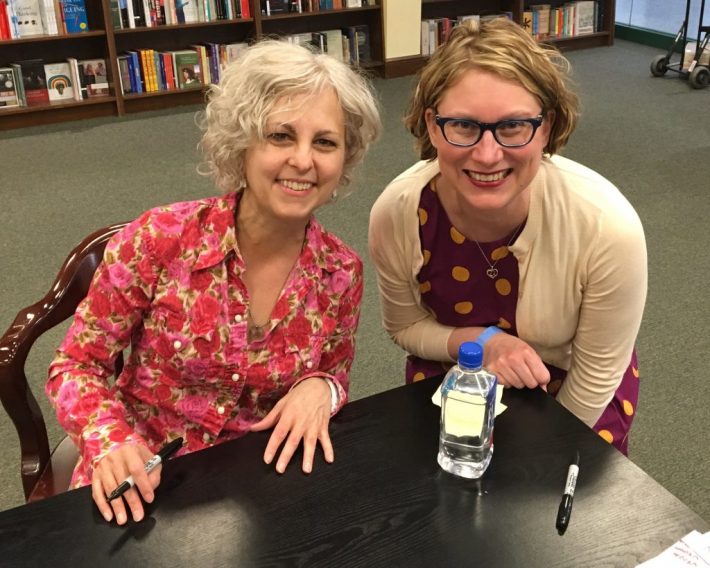Certain words send Kate DiCamillo wandering.
“Prolific” is one of them.
The 61-year-old Minneapolis writer has written 13 novels, 19 chapter books, three picture books, and three short story collections since she published her debut novel, Because of Winn-Dixie, in 2000. These works include Newbery Award winners The Tale of Despereaux (2004) and Flora & Ulysses (2014), as well as the beloved Mercy Watson series of early reader books. In the past year, she’s published four new books, most recently Orris and Timble: Lost and Found in April.
But call this output “prolific” and the humble DiCamillo would demur. The stories found her, she would say, and the characters called out to be written. Her summoning sessions are insignificant—she wakes up every morning, writes two pages, and that’s it.
“The word has now been applied to me with alarming frequency,” DiCamillo says. “I work so slowly, but I guess two pages a day over 25 years, you become prolific.”
Two pages a day is an inadequate way to measure a quarter century of childhood-defining prose, but this simple practice has helped make the 61-year-old DiCamillo the Beverly Cleary of a generation. It gave birth to Opal Buloni, the 10-year-old protagonist of the partially autobiographical Winn-Dixie, a precocious child who has become one of the most enduring figures in modern children’s literature. On Tuesday, August 19, DiCamillo will celebrate the 25 years since she introduced the world to Opal with a Q&A and screening of the 2005 film adaptation Winn-Dixie at the Riverview Theater.
But DiCamillo doesn’t need milestones to inspire her to look back at her career, which she often does with disbelief. She lives it every morning, when she sets herself to the simple, extraordinary task of stumbling into her stories.

From Across a Snow Storm
DiCamillo moved to Minneapolis on a lark in 1994, after a suggestion from a friend. She wasn’t hunting for some big opportunity, just a new place to be. She got a job putting together orders at a gigantic book distributor called The Bookmen in North Loop, and every morning before her shift, she would wake in the dark cold and type her two pages. The practice helped the Florida girl survive the frigid months.
DiCamillo was stationed on the third floor with the children’s literature, and she started leafing through the shipments she was tasked to assemble. The Watsons Go to Birmingham–1963 by Christopher Paul Curtis inspired her to write for a younger audience.
“It’s just this brilliant, funny, warm book that talks about something really huge, and it does it in such an accessible way,” DiCamillo remembers. “And I thought, ‘I want to try to do something like this.’”
In the winter of 1996, DiCamillo was at home getting buried in snow, and she heard a voice.
The flakes fell at three inches per hour. DiCamillo was at work, copying pages of The Watsons Go to Birmingham just to see how it felt to put together a manuscript. She had mainly been working on short stories, but she wanted to try an early reader novel. She describes what happened next as Opal “reaching out” to her.
“Right before falling asleep, I heard this little girl's voice with a southern accent say, ‘I have a dog named Winn-Dixie,’” DiCamillo says. “It was a terrible winter, and it was a shock to a girl from Florida. It was also the first time in my life that I'd really been without a dog for any considerable period of time. That homesickness and that need for a dog became the book.”
Winn-Dixie begins with Opal visiting the local grocery store, looking to buy two tomatoes and some rice. Instead, she finds a “big, ugly, suffering dog with a sterling sense of humor” who has broken into the store and is wreaking havoc. Opal claims the dog, and from that day forward, the two are inseparable. Opal names him Winn-Dixie, and with the mutt at her side, she begins to understand her new home in Florida, her peculiar neighbors, and the truth about why her mother abandoned their family.
DiCamillo’s memory of conceiving Opal and Winn-Dixie is the type of fantastical happenstance the writer has become known for. The book itself has no magical elements, but there are lozenges that taste like sadness and a tree haunted by regrets. This is DiCamillo’s perspective on everything: half magic, half practical. That’s how Winn-Dixie came to be. Or at least, that’s how a storyteller tells it.
“I had no idea what I was doing, which, in a weird way, made it easier,” DiCamillo says. “I would get up, it would be dark and cold, and Opal’s voice just kind of carried me through. I remember at one point thinking, ‘Oh, this is what I'm supposed to be doing.’”

Opal Gets Her Wish
The first draft of Winn-Dixie was completed in June 1997. DiCamillo finished the draft under the tutelage of local children’s writer and literary critic Jane Resh Thomas before convincing a young publisher’s rep from Candlewick Press, Linda Nelson, to take a flyer on the manuscript. Winn-Dixie was published in March 2000 to immediate acclaim.
In 2002, Kristin Johnson was a 34-year-old aspiring writer attending the National Writers Union meeting. The Bloomington native was a fellow mentee of Resh Thomas and a dog lover, so she went to see DiCamillo speak and was so enamored with the effusive upstart writer that she decided to read Winn-Dixie. She’s since read every one of DiCamillo’s 32 books, en route to becoming a well-published children’s and middle-grade writer herself.
Johnson didn’t find Winn-Dixie until she was an adult, but she immediately recognized the little girl in the text. Opal was a true storyteller’s creation, the product of an empath with a fully accessible inner child. DiCamillo remembered the darkness and the hopelessness of being a child in vivid detail, and she gave that to Opal, creating an emotional resonance that has not dulled over a quarter century.
“Kate believes in not giving kids just the shiny stories,” Johnson says. “It's okay to tell them the truth or to go somewhere dark because they already know. They know there's bad things happening in the world, so you don't have to protect them.”
In a 2023 New Yorker profile, DiCamillo revealed the traumatic truth behind how Opal’s life as a motherless kid stuck in a new town mirrored her own childhood. DiCamillo relocated from Pennsylvania to Florida at the age of 5 to help her cope with chronic pneumonia. Her father, an abusive orthodontist who often threatened to kill DiCamillo’s mother, did not follow them south. While DiCamillo only began reckoning with this deep emotional rift two decades after publication, readers have sensed something like it lurking beneath the story since Winn-Dixie first hit shelves.
“We're all trying to fit in in different places, that’s the universal theme,” Johnson says. “One of my mentors said, ‘You're writing behind your back,’ so maybe in your subconscious, these things have come out, but you don’t realize you had them all when you were putting them into the book. But all of a sudden, they're there.”
Opal is not a reflection of DiCamillo’s lived experience, per se. She’s a fantasy of the child DiCamillo wishes she’d been. Opal is sarcastic and willful, wise in ways DiCamillo wasn’t. She carries her preacher father through his mourning, befriending the local librarian, a pet shop owner, and the town recluse as she and her dog meander through town. DiCamillo says her career has been a slow process of “revealing [herself] again and again and again,” and it all started with Opal as an idealized version of her childhood self.
“I was a small kid and a shy kid, but I was a sarcastic kid, and I didn't like to be condescended to,” DiCamillo says. “It’s kind of wish fulfillment. When you're a kid, it's all insignificant. You're treated as a nuisance. To have Opal affect this change on the whole town, it's empowering.”

Writing Behind Her Back
The first time Rachel Smoka-Richardson read Because of Winn-Dixie, she was afraid the dog would die. She read it all in one sitting, and the dog didn’t die. She wept anyway.
It was 2010, and Smoka-Richardson was enrolled at the Vermont College of Fine Arts pursuing her MFA in writing for children and young adults. She decided to do her thesis on Winn-Dixie. She studied three early drafts that had been donated to the Kerlan Collection at the University of Minnesota, revealing how DiCamillo spun that snowy night into a stream-of-conscious digression and slowly formed it into something transcendental.
“Kate [said] it was important to donate those papers so that people like me can realize that anybody can be a writer,” Smoka-Richardson says. “I feel like she's been with me on my own writing journey as I continue to read her books. She's just been so prolific.”
There’s that word again.
In the 15 years since Smoka-Richardson first encountered—and became enamored with—Winn-Dixie, she has become an author in her own right, publishing her debut picture book, Cinderelliot: A Scrumptious Fairytale, in 2022. She now teaches creative writing at Hamline University, where she uses Winn-Dixie as a mentor text.
“Kate has incredible empathy,” Smoka-Richardson says. “She doesn't have children, and yet she speaks to the heart of every child that reads that book.”
Children encounter DiCamillo’s books like sea glass or abalone shells: Their hearts immediately recognize them as treasures. Adults encounter them like diaries of a friend from elementary school. But writers encounter the books like they’ve just been told a great secret. Her connection to other writers like Johnson and Smoka-Richardson is, like her writing, both preternatural and familiar.
“It’s just a magical piece of literature,” she says. “You can read Because of Winn-Dixie, and enjoy it as a book, but to see inside her mind as she was revising was just fascinating. It was such a gift to the writing community.”
Reading the drafts in Smoka-Richardson’s thesis dissolves some of the mystique around how this transplant former bookseller became a cherished fixture in the hearts of children, parents, and writers across the world. In the drafts, you see ink and paper forming into something more. It’s craftsmanship and conjuring all at once—what Smoka-Richardson calls the work of “a master.”
DiCamillo would probably reject that word. She might say that she’s serving something bigger than herself, something that pulls her to wander. And then that’s where the craft comes in.
“There's something that you just don't understand that does seem magical,” DiCamillo says. "But the magic is not going to happen unless you sit down and work.”
25th Anniversary Celebration of Because of Winn-Dixie with Kate DiCamillo
When: 5-9 p.m. Tuesday, August 19
Where: The Riverview Theater, 3800 42nd Ave. S., Minneapolis
Tickets: $20, which includes a paperback copy of the book; click here for tickets







